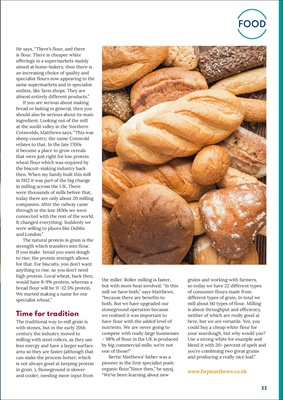
33
FOOD
He says, "There's flour, and there
is flour. There is cheaper white
offerings in a supermarkets mainly
aimed at home-bakers, then there is
an increasing choice of quality and
specialist flours now appearing in the
same supermarkets and in specialist
outlets, like farm shops. They are
almost entirely different products."
If you are serious about making
bread or baking in general, then you
should also be serious about its main
ingredient. Looking out of the mill
at the sunlit valley in the Northern
Cotswolds, Matthews says, "This was
sheep country; the name Cotswold
relates to that. In the late 1700s
it became a place to grow cereals
that were just right for low protein
wheat flour which was required by
the biscuit-making industry back
then. When my family built this mill
in 1912 it was part of the big change
in milling across the UK. There
were thousands of mills before that,
today there are only about 20 milling
companies. After the railway came
through in the late 1850s we were
connected with the rest of the world.
It changed everything. Suddenly we
were selling to places like Dublin
and London."
The natural protein in grain is the
strength which transfers into flour.
If you make bread you want dough
to rise; the protein strength allows
for that. For biscuits, you don't want
anything to rise, so you don't need
high protein. Local wheat, back then,
would have 8-9% protein, whereas a
bread flour will be 11 -12.5% protein.
We started making a name for our
specialist wheat."
Time for tradition
The traditional way to mill grain is
with stones, but in the early 20th
century the industry moved to
milling with steel rollers, as they use
less energy and have a larger surface
area so they are faster (although that
can make the process hotter, which
is not always good at keeping protein
in grain. ). Stoneground is slower and
cooler, needing more input from
He says, "There's flour, and there
is flour. There is cheaper white
offerings in a supermarkets mainly
aimed at home-bakers, then there is
an increasing choice of quality and
specialist flours now appearing in the
same supermarkets and in specialist
outlets, like farm shops. They are
almost entirely different products."
If you are serious about making
bread or baking in general, then you
should also be serious about its main
ingredient. Looking out of the mill
at the sunlit valley in the Northern
Cotswolds, Matthews says, "This was
sheep country; the name Cotswold
relates to that. In the late 1700s
it became a place to grow cereals
that were just right for low protein
wheat flour which was required by
the biscuit-making industry back
then. When my family built this mill
in 1912 it was part of the big change
in milling across the UK. There
were thousands of mills before that,
today there are only about 20 milling
companies. After the railway came
through in the late 1850s we were
connected with the rest of the world.
It changed everything. Suddenly we
were selling to places like Dublin
and London.
The natural protein in grain is the
strength which transfers into flour.
If you make bread you want dough
to rise; the protein strength allows
for that. For biscuits, you don't want
anything to rise, so you don't need
high protein. Local wheat, back then,
would have 8-9% protein, whereas a
bread flour will be 11 -12.5% protein.
We started making a name for our
specialist wheat."
www.fwpmatthews.co.uk